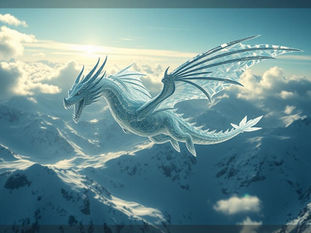
Unlocking Midjourney V7: A Beginner's Guide to Prompt Engineering
Apr 21
5 min read
0
1
0

Want to create amazing images with Midjourney? It all starts with crafting the perfect prompt. This guide breaks down the key concepts and provides practical tips to help you get the most out of Midjourney, even if you're just starting out.
Getting Started with Midjourney Prompts
Warming Up: Interacting with the Midjourney Community
Before diving into the technical stuff, let's make sure everyone knows how to engage within the Midjourney community. Feel free to drop a "hello" in the chat, share your favorite color, or ask any questions you might have. Don't be shy – participation is key to learning and growing!
The Allure of Midjourney: Binge-Watching Your Imagination
Have you ever found yourself completely absorbed in Midjourney, creating image after image? It's easy to lose track of time as you explore the endless possibilities. This immersive experience can even lead to something called neuroplasticity, where your brain becomes more attuned to visual details and artistic nuances. You might start noticing colors, textures, and compositions in everyday life that you never saw before.
Have you ever caught yourself thinking, "That would make a great Midjourney prompt?" If so, you're already on the right track. Want to take your Midjourney skills to the next level? Explore the Midjourney Automation Suite from TitanXT and unlock new possibilities for your creative journey.
Understanding How Midjourney Works
The Goal: Troubleshooting and Improving Your Prompts
The aim isn't to teach you the "right" way to prompt, but to equip you with a framework for troubleshooting when your prompts don't deliver the desired results. By understanding the underlying mechanics, you can make informed adjustments and increase your chances of success.
The Bottom Line: Key Factors for Prompt Performance
Why do some prompts fall flat? Here are the key reasons:
Lack of Control: If you don't specify certain details in your prompt, Midjourney will fill in the gaps using its "best guess," which might not align with your vision. Aim to control all the important aspects of the image you want to create.
Processing Time: Each prompt is a timed job on Midjourney's servers. If your request takes too long to process, the AI might start blending details or producing incoherent results. While this is less of a concern in V7, it's still good to be mindful of prompt optimization.
Chaotic Tokens: Avoid conversational instructions (unless using conversational mode) and prompts that resemble a novel. Focus on using words with clear visual meaning.
Poor Structure: Grammar and punctuation matter. A jumbled list of words won't be as effective as a well-structured sentence that clearly describes the desired image.
Diffusion, Denoising, and Seeds: Peeking Behind the Curtain
Midjourney uses a process called diffusion to generate images. It starts with random visual noise (the "seed") and gradually refines it based on your prompt, making billions of tiny adjustments to the pixels. This process is called denoising.
While seeds can theoretically allow you to recreate a specific image, they're not a reliable way to maintain consistency long-term due to the random assignment of jobs to different GPUs. The most valuable application of a seed is during testing when you are sending jobs fast enough to potentially hit the same GPU.
Midjourney shows an abbreviated form of denoising with every prompt. It only has so much time to produce your image before it runs out of time. That's why prompt optimization is important.
Controlling the Canvas: Mastering the Art of Prompting
Avoiding the "Aggressively Normal": Taking Charge of Your Image
When Midjourney fills in the gaps, it tends to play it safe, relying on stereotypes and archetypes. To create truly unique and compelling images, you need to take control and specify the details yourself. Don't leave too much to chance – guide Midjourney towards your desired outcome.
If you're unsure how your prompt will turn out, use draft mode to experiment without incurring costs. It's a great way to test different ideas and refine your approach. Want to streamline your Midjourney workflow? The Midjourney Automation Suite from TitanXT offers tools to enhance your creative process and boost productivity.
Prompt Ordering: Structuring Your Prompts for Success
While prompt ordering isn't as critical in V7 as it was in older models, it's still a useful technique for ensuring you cover all the necessary details. A good approach is to think in terms of style, subject, and background:
How should it look? (Style)
What's in the image? (Subject)
Where is it? (Background)
By addressing these three elements, you can create more comprehensive prompts that leave less room for Midjourney to make unwanted assumptions.
Leveraging Compound Subjects and Archetypes
Compound subjects (like "family" or "armada") can help you add more details to your image without consuming excessive processing time. They're like cheat codes for visual storytelling. Another method is understanding and invoking archetypes. By invoking an archetype, you can make Midjourney supply all the default details automatically, using less processing time than describing each element individually.
However, there are times when you'll want to avoid archetypes and use the describe method to control undesirable outcomes. It's important to recognize archetypes and understand when to embrace them and when to break them.
Optimizing Your Prompts: Techniques for Efficiency
Invoking vs. Describing: A Balancing Act
An archetype is the dominant representation of something in Midjourney's dataset. You can either describe the thing yourself or invoke the archetype and let Midjourney handle the stereotypical details.
Using archetypes makes your prompt efficient, and letting Midjourney supply the default, archetypical details uses less processing time than describing the element yourself. At the same time, you want to learn to avoid them and use the describe method to control the undesirable outcomes in the images you create.
Words That Midjourney Understands
Avoiding Chaotic Tokens: Speaking Midjourney's Language
Chaotic tokens are words and phrases that Midjourney struggles to translate into visuals. Examples include conversational instructions, jargon, and abstract concepts. To avoid these, focus on using dense, visual language that provides concrete details about the desired image.
The Power of Photography Terms (and Their Limitations)
While it's tempting to use photographic metadata in your prompts (like aperture or ISO), these terms often have a weak correlation and can produce inconsistent results. Instead, try using iconic photographic styles (like "Polaroid" or "Leica") or sourcing to a famous photographer (like Ansel Adams) to achieve more reliable and visually compelling results. Need help crafting the perfect prompt? The Midjourney Automation Suite from TitanXT offers features to refine your prompts and explore new creative avenues.
Conclusion
By understanding how Midjourney works, controlling the canvas, and using the right language, you can unlock its full potential and create truly stunning images. Remember to experiment, iterate, and have fun along the way!






